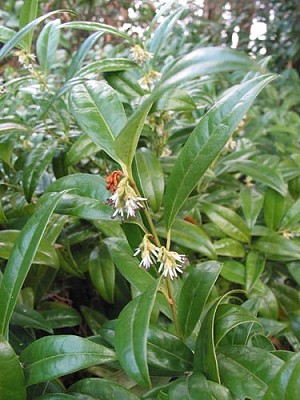
|
|
Sweet
Box (Sarcococca hookeriana)
|
Sweet
Box - Sarcococca Spp.
Sarcococca (Sweet box) is a genus of 16-20 species of flowering plants in the family
Buxaceae, native to eastern and southeastern Asia and the Himalaya. They are
slow-growing evergreen shrubs 1-2 m tall. The leaves are borne alternately, 3-12 cm long and 1-4 cm
broad. They bear fragrant flowers, often in winter. The fruit is a red or black drupe containing 1-3
seeds. Some species are cultivated for ground cover in shady areas. The genus name is a redundancy meaning Fruit
(Sarcos) Berries (Cocca), as the drupes do provide the shrub a most attractive
feature.
This is a much overlooked evergreen sub genus of about 11 species, native from Afghanistan to China and the
Philippines. Apart from one species - Sarcococca saligna, from Afghanistan to Nepal - the
flowers, though small, are very fragrant. Even on a frosty morning their scent prevades the still
air. They are also extremely useful plants for dry, shady situations.
Sarcococca hookeriana was named for Joseph Hooker (Sir. Joseph Hooker (1817-1911), Director of the Royal Botanic
Gardens) who collected widely in the Sikkim Himalayas in 1848/9 and greatly added to the botanical knowledge of this
area. This species, native to the eastern Himalayas and on to south-east Tibet, is not as hardy as its varieties from further
east, although it did receive an Award of Merit in 1936.
Sarcococca hookeriana is an evergreen
shrub, spreading readily by suckers, with bright green stems which will grow in favourable areas to 2m (6'). The leaves are bright
green, shiny and lanceolate with a pointed tip and a wedge-shaped base. The fragrant
flowers, which appear in the axils of the leaves, are unisexual and
white. The tiny stigmatic flowers are found just below the male flowers. These are followed by
shiny, black berries.
Its Chinese variety digyna was introduced by Ernest Wilson in 1908 and this has proved to be hardier than the
species, and it is dwarfer too. It is distinguished by its two (instead of
three) styles on the female flowers; the male flowers have cream-coloured
anthers. This plant received an Award of Merit in 1970 and the Award of Garden Merit in 1984.
Sarcococca hookeriana var humilis (sometimes given specific status) is a native of west China and was first found by Augustine Henry but introduced by Ernest Wilson in 1907. It differs in its elliptic
leaves, pink anthers and dwarfer stature. It too suckers to form dense
patches. Its berries are small and shiny black.
Starting in February & throughout late
winter, the little shrubs are covered with tiny creamy-white tubular flowers that release sufficient perfume to really spice up a shadilly enclosed
garden.
The shrub is self-pollinating. The male flowers have pink anthers; the female flowers have two
styles. Flowers are followed by purple-black berries which add considerable ornamental
value.
According to one story Sarcococca hookeriana is named after General Joseph Hooker from the
american civil war. Surely sarcococca hookeriana was named for Joseph Dalton Hooker
(arguably the most important British botanist of the nineteenth century. A traveller and
plant-collector, he was one of Charles Darwin's closest friends and eventually became director of Britain's Royal Botanic
Gardens, Kew) rather than general Hooker! However General Hooker is responsible
for another name.
Our modern day streetwalkers that we also know as
'hookers' today got that name as back in the civil war days a band of prostitutes would follow General Hooker's troops and camp nearby them so they could make some money by
'servicing' Hooker's troops!
Source:
http://en.wikipedia.org/wiki/Sarcococca
http://www.st-andrews.ac.uk/~gdk/stabotanic/feb06pom.htm
http://www.paghat.com/sarcococcahumilis.html
http://forums.gardenweb.com/forums/ load/ohioval/msg0613372713855.html
